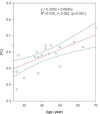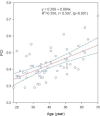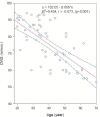Physiological cost index and comfort walking speed in two level lower limb amputees having no vascular disease
- PMID: 25870485
- PMCID: PMC4384862
- DOI: 10.5455/aim.2015.23.12-17
Physiological cost index and comfort walking speed in two level lower limb amputees having no vascular disease
Abstract
Background: The Physiological Cost Index (PCI) was introduced by MacGregor to estimate the energy cost in walking of healthy people, also it has been reported for persons with lower limb amputation, walking with prosthesis.
Objective: To assess energy cost and walking speed in two level lower limb amputation: transfemoral and transtibial amputation and to determine if the age and prosthetic walking supported with walking aids have impact on energy cost and walking speed.
Methods: A prospective cross sectional study was performed in two level lower limb amputees with no vascular disease who were rehabilitated at the Department of Prosthetics and Orthotics at the University Clinical Center of Kosovo. The Physiological Cost Index (PCI) was assessed by five minutes of continuous indoor walking at Comfort Walking Speed (CWS).
Results: Eighty three lower limb amputees were recruited. It is shown relevant impact of level of amputation in PCI (t=6.8, p<0.001) and CWS (T=487, p<0.001). The great influence of using crutches during prosthetic walking in PCI (ANOVA F= 39.5 P < 0.001) and CWS (ANOVA F=32.01, P <0.001) has been shown by One Way ANOVA test. The correlation coefficient (R) showed a significant correlation of age with PCI and CWS in both groups of amputation.
Conclusions: Walking with transfemoral prosthesis or using walking aids during prosthetic ambulation is matched with higher cost of energy and slower walking speed. Advanced age was shown with high impact on PCI and CWS in both groups of amputees.
Keywords: age; amputation; comfort walking speed; crutches; physiological cost index.
Conflict of interest statement
Figures




References
-
- Mac Gregor J. The evaluation of patient performance using long-term ambulatory monitoring technique in the domiciliary environment. Physiotherapy. 1981;67:30–33. - PubMed
-
- Astrand PO, Rodahl K. 3rd Edition. New York: Mc-Graw-Hill; 1986. Textbook of Work Physiology.
-
- Ijzerman MJ, Baardman G, van’t Hof MA, Boom HBK, Her-mens HJ, Veltink PH. Validity and reproducibility of crutch force and heart rate measurements to assess energy expenditure of paraplegic gait. Arch Phys Med Rehabil. 1999;80:1017–1023. - PubMed
-
- Kavlak Y, Uygur F, Korkmaz C, Bek N. Outcome of orthoses intervention in the rheumatoid foot. Foot Ankle Int. 2003 Jun;24(6):494–499. - PubMed
-
- Danielsson A, Willén C, Sunnerhagen KS. Measurement of energy cost by the Physiological Cost Index in walking after stroke. Arch Phys Med Rehabil. 2007;88:1298–1303. - PubMed
LinkOut - more resources
Full Text Sources
Other Literature Sources
Miscellaneous
